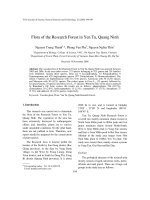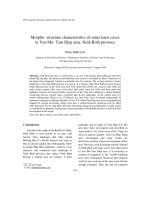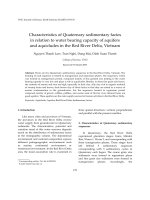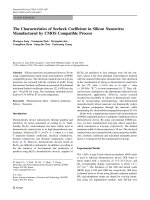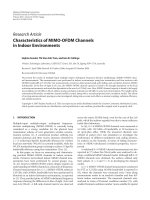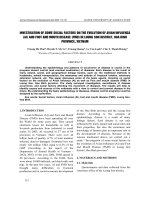Temporal infiltration characteristics of soil under different ages of acacia plantation forest in luong son headwater hoa binh viet nam
Bạn đang xem bản rút gọn của tài liệu. Xem và tải ngay bản đầy đủ của tài liệu tại đây (2.35 MB, 59 trang )
MINISTRY OF AGRICULTURE AND RURAL DEVELOPMENT
VIETNAM NATIONAL UNIVERSITY OF FORESTRY
STUDENT THESIS
TEMPORAL INFILTRATION CHARACTERISTICS OF SOIL UNDER DIFFERENT
AGES OF ACACIA PLANTATION FOREST IN LUONG SON HEADWATER,
HOA BINH, VIETNAM
Major: Advanced Curriculum in Natural Resources Management
Code: D850101
Faculty: Forest Resources & Environmental Management
Student: Dang Thi Thanh Hoa
Student ID: 1553090300
Class: K60A - Natural Resources Management
Course: 2015 – 2019
Advanced Education Program
Developed in Collaboration with Colorado State University, USA
Supervisor: Assoc. Prof. Bui Xuan Dung
Hanoi, 2019
ACKNOWLEDGEMENT
First of all, I would like to express my trustworthy respect to my supervisor –
Assoc. Prof. Dr. Bui Xuan Dung for his enthusiastic support with invaluable comments.
Additionally, I appreciated the support of other lectures during the time I analyzed the data.
Furthermore, I also thank to my friends when I started to set up in the field to collect
and during the time I analyzed data. They always give me the support whenever I needed
regardless of hardship.
Finally, I respected local people who own the Acacia plantation model for allowing and
provided me detailed information to conduct this research in this site and.
Hanoi, September 2019
i
TABLE OF CONTENT
ACKNOWLEDGEMENT...................................................................................................... i
TABLE OF CONTENT ........................................................................................................ ii
LIST OF TABLE ................................................................................................................. iv
LIST OF FIGURE ................................................................................................................ v
ABSTRACT ......................................................................................................................... 1
CHAPTER I.......................................................................................................................... 2
INTRODUCTION ................................................................................................................ 2
CHAPTER II ........................................................................................................................ 5
GOALS AND OBJECTIVES................................................................................................ 5
2.1. Goal ............................................................................................................................... 5
2.2.
Objectives .................................................................................................................. 5
CHAPTER III ....................................................................................................................... 6
STUDY SITE AND METHODS........................................................................................... 6
3.1. Study site ....................................................................................................................... 6
3.2. Methods ....................................................................................................................... 10
3.2.1. Temporal infiltration measurement ............................................................................ 10
3.2.3. Soil properties ........................................................................................................... 13
CHAPTER IV. .................................................................................................................... 16
RESULTS AND DISCUSSIONS........................................................................................ 16
ii
4.1. Soil infiltration characteristics at different ages of Acacia plantation ............................ 16
4.1.1. Infiltration rate at different ages of Acacia plantation forest ...................................... 16
4.1.2. Initial and stable infiltration rate of soil under six conditions .................................... 23
4.1.3. Total water infiltration in 1 hour ............................................................................... 28
4.2. Impact factors on Infiltration characteristics at different ages of Acacia plantation ....... 30
4.2.1. Soil physical and vegetation characteristics at different ages of Acacia plantation ..... 30
4.2.2. Affecting factors on soil infiltration at different ages of Acacia plantation ................. 38
CHAPTER V ...................................................................................................................... 45
CONCLUSION................................................................................................................... 45
5.1. Conclusion ................................................................................................................... 45
5.2. Limitations ................................................................................................................... 46
5.3. Recommendations ........................................................................................................ 46
REFERENCES ................................................................................................................... 48
APENDIX .......................................................................................................................... 51
iii
LIST OF TABLE
Table 3.1. Data of infiltration in different ages Acacia Forest………………………..………..12
Table 3.2. Information of Survey plots.....……………………………………………….……12
Table 4.1. Summary of the paired mean comparison of initial rate and stable rate at different
ages of Acacia plantation……………………………………………………………….……..27
Table 4.2. Vegetation characteristics at different ages of Acacia Plantation…..……………....29
iv
LIST OF FIGURE
Figure 3.1. The map of study site: a) Location of Hoa Binh province on Vietnam map; b)
Location of Luong Son district on Hoa Binh map; c) Location of Truong Son commune on
Luong Son map ...................................................................................................................... 7
Figure 3.2. Contour map of study site:.................................................................................... 8
Figure 3.3. Morpholygy of Acacia mangium .......................................................................... 9
Figure 3.4. Infiltration measurement in Acacia plantation..................................................... 11
Figure 3.5. Dry Bulk Density Tube ...................................................................................... 14
Figure 3.6. Soil analysis in laboratory by using oven ............................................................ 15
Figure 3.7. Determine slope, coordinate system and understory vegetation cover ................. 15
Figure 3.8. Data analysis ...................................................................................................... 15
Figure 4.1. Infiltration rate of bare land ................................................................................ 16
Figure 4.2. Infiltration rate of 1-year-old Acacia plantation .................................................. 17
Figure 4.3. Infiltration rate of 2-year-old Acacia plantation .................................................. 18
Figure 4.4. Infiltration rate of 3-year-old Acacia plantation .................................................. 19
Figure 4.5. Infiltration rate of 4-year-old Acacia plantation .................................................. 20
Figure 4.6. Infiltration rate of 5-year-old Acacia plantation .................................................. 21
Figure 4.7. Average infiltration rate at different ages Acacia plantation ................................ 22
Figure 4.8. Initial infiltration rate of 6 different condition covers ......................................... 23
Figure 4.9. Stable infiltration rate of 6 different condition covers ......................................... 25
Figure 4.10. Correlation between Stable rate and Initial rate ................................................. 26
Figure 4.11. Total infiltration in 1 hour under different vegetation cover types ..................... 28
Figure 4.12. Total infiltration in 1 hour of other studies (Dung, 2015; Dung et al, 2016; Linh,
2017; Lan, 2018; Dung et al., 2019) ..................................................................................... 29
Figure 4.13. Dry bulk density of 6 different ages Acacia plantation ...................................... 31
v
Figure 4.14. Porosity of 6 different ages Acacia plantation ................................................... 33
Figure 4.15. Soil moisture of 6 different ages Acacia plantation ........................................... 35
Figure 4.16. Understory vegetation coverage of 4 different ages Acacia plantation............... 36
Figure 4.17. Affecting factors on infiltration of soil .............................................................. 38
Figure 4.18. Correlation between initial rate and soil moisture ............................................. 39
Figure 4.19. Correlation between initial rate and porosity ..................................................... 39
Figure 4.20. Correlation between initial rate and understory vegetation coverage ................. 40
Figure 4.21. Correlation between: a) Stable rate and porosity; b) Stable rate and dry bulk
density ................................................................................................................................. 41
Figure 4.22. Correlation between Stable rate and Understory vegetation cover. .................... 42
Figure 4.23. Storm events of study site (Dung et al., 2019) ................................................... 43
vi
ABSTRACT
To determine the temporal infiltration characteristics of soil under different ages of
Acacia plantation forest in Luong Son head water, Hoa Binh Province, Vietnam. The field
experiment for infiltration measurement was established at different vegetation cover
conditions (including bare land after burning, 1 years-old Acacia trees, 2-year-old Acacia trees,
3-year-old Acacia trees, 4-year-old Acacia trees and 5-year-old Acacia trees) from July to
September 2019. A number of affecting factors were determined, including soil physical
characteristics and vegetation characteristics of Acacia plantation in Truong Son Commune,
Luong Son district, Hoa Binh Province. The main findings included: (1) Temporal infiltration
rate in six different ages of Acacia plantation tended to be decreased over time. Both initial and
stable rate are increase from bare land after burning to 5-year-old of Acacia Mangium forest;
(2) Temporal infiltration rate has a strong relationship with soil physical characteristics and
understory vegetation cover. Initial infiltration rate of soil has a strong relationship with
understory vegetation, porosity and soil moisture, but do not have significant relationship dry
bulk density. While stable rate has a moderate relationship with understory vegetation, it has a
weak relationship with porosity, dry bulk density and soil moisture; (3) The findings implied
that infiltration rate under Acacia plantation forest has been higher than bare land after burning.
It can be explained that the root and understory vegetation have important impacts on
infiltration characteristics of soil.
Key words: Acacia plantation model, bare land after burning, infiltration,
headwater, porosity vegetation cover conditions
1
CHAPTER I
INTRODUCTION
Infiltration is the process by which water on the ground surface enter the soil or other
materials and it is commonly used in both the field of hydrology and soil science in term of
watershed management (Horton, 1933). The characteristics of infiltration can determine the
establishment of surface and subsurface flow, which can control the hydrological processes and
factors, including peak flow rates, runoff volumes, soil erosion and plant-available water
capacity. In terms of the location which has higher infiltration rate, there is no chance or little
of generating overland flow (Horton, 1933). Therefore, the frequency of phenomenon of soil
erosion is low or even not occurring if the infiltration of soil is high and soil will absorb water
rapidly. On the other hand, there will be frequently degrading issues, including landslide and
soil erosion caused by overland flow and low infiltration capacity (Hai, 1993). Regarding
surface flow, infiltration is indicative of the capability of the most significant regulator factor
in forest hydrology, after rainfall has passed through the atmosphere, vegetation coverage and
fallen cover (Sharma el al, 1980). Therefore, it is easier to effectively manage land and water
resources, infiltration rate plays an important role in watershed management. Many researches
have focus on the key influencing objects of infiltration rate, including soil characteristics,
rainfall and vegetation covers to emphasize the importance of infiltration (Dien et al, 2006).
It can be said that a number of factors affecting infiltration rate of soil, such as
precipitation characteristics, soil characteristics, terrain and vegetation and combine the amount
of rain, intensity and frequency of rainfall (Dien el al, 2006), especially the role of vegetation
in improving the infiltration rate of soil (Hiraoka, 2010). With the respect to heavy rainfall and
intensity of rainfall, the infiltration of the soil witnessed the trend to be small. Regarding
precipitation and intensity of rainy season, the infiltration capacity will be higher (Haws el al,
2014). Soil factors that control infiltration rate are vegetation cover, root development, organic
2
content (Dune et al, 1991). Additionally, some factors such as soil moisture, bulk density,
porosity, soil texture and structure also have significant effects on infiltration rate. Among three
factors that influence the infiltration of soil, we can manage two factors including soil
characteristics and vegetation. Therefore, management approaches are also concentrated on
these two factors. Previous studies on surface runoff and soil erosion by Lung and Hai (1997)
show that the thicker the forest is, the more water is absorbed into the soil and turned into the
underground flow. In addition, the study research of Lung et al. (1995) show that permeability
is considered to be a major factor in erosion and flow. The authors affirmed that in Vietnam,
forest trees are capable of consuming a large amount of water. At the same time, affirmation of
forest land is also a factor that influences the infiltration velocity. Differences in soil properties,
mainly the physical properties of soils, will directly affect the soil's infiltration. Lung (1992)
relies on permeability, transpiration and degradation of soils for scoring and evaluates the role
of soil factors on infiltration.
In terms of vegetation cover factor, plantation forest is very popular these days. In
Vietnam, about 24% of the forest area is planted forest, in which Acacia Mangium is a popular
crop. Acacia Mangium Wild., also known as Mangium, is a species of indigenous plants to
Northern Queensland (Australia), found in Indonesia's Irian Jaya, Maluku (Doran and Skelton,
1982). This is a fast-growing species, which is widely used for various purposes such as timber,
firewood, agroforestry, land improvement (Turnbull et.al, 1983. Acacia belong to Fabaceae
family, which is believed to have nitrate fixation ability and make soil become better (May et
al, 2003). Thus it helps to conserve soil, promote vegetation development (Brockwell et al,
2005). Some hypotheses have supposed that the oil fallen leaves of Acacia Mangium has
negative effects on understory vegetation. The loss of understory vegetation can reduce
infiltration capacity of soil and lead to the increase of overland flow and soil erosion. Therefore,
in this research, experiment on infiltration can observe the infiltration capacity of soil under 6
3
different ages of Acacia trees to conclude whether this hypothesis is right or not. In general, the
study of infiltration characteristic of soil in Vietnam is carried out in three directions (Lan el al,
2010). First, using natural rainfall, in this way some authors simultaneously measure
precipitation, surface runoff and evapotranspiration. The amount of water absorbed at this time
is calculated as the difference between rainfall and surface flow with evaporation. The next way
is to use artificial rain, the amount of water is now also calculated by the difference between
the amount of water supply and surface water flow. The third direction is to use the infiltrometer
ring. In this research, the measurement of infiltration experiment was conducted by using
double-ring infiltrometer to identify the infiltration characteristics soil and the affecting factors
on infiltration under soil of Acacia plantation forest.
These days, the research on infiltration in Vietnam is limited. In Hoa Binh province,
Acacia Mangium is one of the grown plants which occur about 92% amount of forest areas
because of academic value and growth conditions suitable for watershed. Though the research
on effect increase infiltration capacity through the development stages of Acacia Mangium, I
conduct this study with title: “TEMPORAL INFILTRATION CHARACTERISTICS OF
SOIL AT DIFFERENT AGES OF ACACIA PLANTATION FOREST IN LUONG SON
HEADWATER, HOA BINH, VIETNAM”. Based on the results of the research, the
interaction between the ages of Acacia Mangium and infiltration rate of soil will be determined,
then some suggestions will be provided to get effective watershed management in the headwater
of Hoa Binh, Vietnam, especially in soil and water resources management.
4
CHAPTER II
GOALS AND OBJECTIVES
2.1. Goal
To determine infiltration characteristics of soil under different ages of Acacia
plantation forest model, then to propose some solutions for more effective and sustainable
watershed management in Acacia plantation forest.
2.2. Objectives
Hypothesis:
The vegetation cover condition plays a significant role in protecting soil quality and
increasing the infiltration of soil. The infiltration capacity in Acacia Mangium plantation forest
is much higher than bare land.
The specific objectives of this research are:
To determine the temporal infiltration characteristics of soil under different ages of
Acacia plantation forest in Luong Son headwater.
To evaluate the factors affecting infiltration characteristics of soil under different ages
of Acacia plantation forest in Luong Son headwater.
To give some practical suggestions to increase the infiltration capacity for better
approaches for Acacia plantation forest.
5
CHAPTER III
STUDY SITE AND METHODS
3.1. Study site
The study is in Chanh village, Truong Son commune, Luong Son district, Hoa Binh
province. Truong Son is a remote commune of Luong Son district, Hoa Binh province, a
commune is far about 8 km southwest of the district center; the East of the commune shares its
borders with Cao Ram commune, Tan Vinh commune (Luong Son district) to the West,
adjacent to Dan Ha commune, Doc Lap commune, Mong Hoa commune (Ky Son district), the
South of the commune shares its borders to Du Sang commune (Kim Boi district) and the North
of Truong Son shares its borders the commune Dan Hoa (Ky Son district) Lam Son commune
Luong Son district. The area of Truong Son commune is about 3,060 ha, in which agricultural
land is 2,728 ha; non-agricultural land 152 ha; Unused land is 180 ha. The population who live
in this location is about 2,312 people in 2014. There are 3 ethnics living in Truong Son
Commune, including Muong (96%), Kinh (3%) and Dao (1%) (People’s Committee of Hoa
Binh Province, 2015).
- Regarding the topography, Luong Son district is located in the midland - where the
transition between the delta and mountainous, so the terrain is very diverse. The low
mountainous terrain is approximately 200-400m in height, formed by magma, limestone and
erogenous sediments, with a dense network of rivers and streams with quite small slope, which
have storage function. Therefore, it is beneficial for the irrigation activities of people to develop
the agriculture and other cultivation.
- Luong Son climate is tropical monsoon, with the winter is cold and, little rainfall; the
summer is hot and much precipitation. The average temperature of the year is 22.9 - 23.30°C.
The average rainfall is from 1,520.7 to 2,255.6 mm/year, but unevenly distributed during the
year. The average precipitation is 276 – 322 mm/month, but the distribution of precipitation is
6
not uneven within one year and seasons with a number of big storms in rainy reason. As a
results, heavy rain can affect to the soil and cause the phenomenon of soil erosion and landslides
in steep mountainous area located in Truong Son commune, Luong Son district, Hoa Binh
province.
- The commune has Truong Son A road passing from Highway 6 through Tan Vinh
commune, Luong Son district to Du Sang commune, Kim Boi district, with a convenient traffic
system, creating favorable conditions for Truong Son people to develop their economy
(People’s Committee of Hoa Binh Province, 2015).
Figure 3.1. The map of study site: a) Location of Hoa Binh province on Vietnam map; b)
Location of Luong Son district on Hoa Binh map; c) Location of Truong Son commune on
Luong Son map
7
Figure 3.2. Contour map of study site:
8
Characteristics of tree species: Acacia mangium
Figure 3.3. Morpholygy of Acacia mangium
Scientific name: Acacia mangium
Family: Fabaceae
Area: 162,200.8 hectares
Average productivity is about 120m3 / ha, giving high income with about 80 million dong/ha
Nitrogen mineralization ability to improve soil.
Characteristics:
Acacia mangium is a species of Fabaceae family, that is native to northeastern Queensland in
Australia. In Vietnam, Acacia mangium is the most widely planted in the North West, Central,
9
North East, Red River Delta, North Central, South Central, Central Highlands, South East, South
West
The average tree height is 25-30 m, diameter 40-50 cm, straight stem, small branches, pruning good
nature, preferring hot and humid climate.
A. mangium is light-tolerant, fast growing after planting from 8-10 years of age for logging.
Uses:
A. mangium trees produce sapwood and heartwood. The heartwood's color is brownish yellow
shimmery and medium textured. Since these trees crack easily and temperamental for use in
furniture, this is mainly used for the paper pulp and biomass Fuel industries. Both industries will
require the A. mangium trees to be chipped and delivered by the ton and moisture rates. An
important use of A. mangium is soil management and ecological restoration. Because Acacia
mangium trees largely increase the turnover rate of N in the topsoil, it might also improve the
mineral N availability in soils in mixed cultures. Due to the fact that it is a very fast growing tree it
develops an intensive rooting system, particularly in a low fertility soil (Voigtlaender M. et al.
2012). That helps to recover degraded tropical lands for what A. mangium is very useful (Kadir
W.R, Kadir A.A., Van Cleemput O., Zaharah Abdul Rahman. 1996).
3.2. Methods
This study was conducted in 6 areas, which have 6 different vegetation conditions.
These sites were for bare land after burning, 1-year-old Acacia tree, 2-year-old Acacia tree, 3year-old Acacia tree, 4-year-old Acacia tree and 5-year-old Acacia tree, with the time from 10th
July to 20th of August (Figure 3.2)
3.2.1. Temporal infiltration measurement
Double-ring infiltrometer was used to measure the temporal infiltration characteristics
of different condition covers. Ring was 20cm inner and 25cm outer diameter and made from
10
steel with sharpened bottom edges. A big hammer was used to place rings into the soil with a
depth of 5cm. Grass was cut to near soil level. In generally, the water level was kept at or above
5 cm depth (plug a sharp nail into center of the inner ring, then keep the nail 5cm above the
soil. Cylinder was used to pour the water slowly into the ring of 5 cm initial water above the
topsoil, with 10-cm nail (Figure 3.4).
Figure 3.4. Infiltration measurement in Acacia plantation
Step 1: Drive the ring into the ground up to the three-inch mark. The best way to do this is to
pound a small block of wood laying across the ring with a mallet. Firm the soil around the inside
of the ring.
Step 2: Put a nail in to the ground of the center of the ring, the nail has the length of 5cm after
plugged into the soil. In general, the water level was kept at or above 5 cm depth.
Step 3: Using a cylinder to pour the water slowly into the ring of 5 cm initial water above the
topsoil, with 10cm nail. Record in each minute how many water infiltrates.
11
Measure 5 locations in each forest type from July 10th to August 20th 2019, each location
was measured about 95-100 minutes to reach the stable rate.
Table 3.1. Data of infiltration in different ages Acacia forest
Date:
Implementer:
Location:
Weather 3 days before:
Canopy Cover:
Under soil vegetation cover (%):
Initial water level: 5cm
Diameter of ring:
No
Time (minute)
1
5
2
10
...
.....
100
100
ΔH (additional water)
The characteristics were recorded in the table below:
Table 3.2. Information of survey plots
Parameters
1-year-
2-year-
3-year-
4-year-
5-year-
old-tree
old-tree
old-tree
old-tree
old-tree
Bare land
Date
Slope (o)
Elevation
Soil Depth
DBH (cm)
Height (m)
12
Understory
Vegetation Cover
(%)
Canopy cover (%)
Crown diameter
(m)
Crown length (m)
3.2.3. Soil properties
a. Particle density (d)
The particle density of soil (d) is the ratio between the weights (grams) per unit of soil
(cm3) in the solid and dry state (in which the soil particles stay tightly) and the weight of water
that have the same volume.
d = P / (P + P1 - P2)
In which: d: Solid Density
P: Weight of dry land taken for analysis (g)
P1: Mass of picnomet that contain water (g)
P2: The mass of picnomet that contain water and soil (g)
Normally, the particle density varies from to 2.5 to 2.7 g/cm3. the average particle of
soil in Viet Nam is about 2.65 g/cm3. Hence 2.65 g/cm3 is chosen to be the particle density of
soil in this research for calculation.
b. Dry bulk density
• Dry Bulk Density Tube was used to collect soil in order to determine bulk density
Dry Bulk density (D) is the weight of a unit volume of a loose material (such as a powder
or soil) to the same volume of water (g/cm3). Calculated by using this formula:
D=M/V
13
In which: D: Dry Bulk density (g / cm3)
M: Weight of dry land in its natural state (g)
V: The volume of the cylinder (cm3)
Figure 3.5. Dry Bulk Density Tube
c. Porosity
Porosity of the soil is the ratio of the pores in the soil compared to the volume of soil.
The porosity of the soil is determined by the particle density and the Dry Bulk density of the
soil. Porosity is calculated by using the formula:
X% = (1-D / d) * 100
In which:
d: is the particle density (g / cm3)
D: is the bulk density (g / cm3)
d. Soil moisture
Determination of soil moisture following steps
Step 1: Weigh the aluminum box, (W1) (g)
Step 2: Weigh soil and aluminum box, we got W2 (g)
Step 3: After 24 hours drying in an oven at a temperature of 105⁰C, weight soil and
aluminum and we got W3 (g). Calculated according to the following formula:
W% =
𝑊2−𝑊3
𝑊2−𝑊1
* 100
14
Figure 3.6. Soil analysis in laboratory by using oven
3.2.3. Understory and vegetation cover characteristics.
Canopy Cover Free was used to determine understory vegetation cover.
The equipment and software including GPS, GLAMA, Caliper, Blume Leiss, measuring
tape to determine slope, coordinate system and grow data
Figure 3.7. Determine slope, coordinate system and understory vegetation cover
3.2.4. Data Analysis: Data was analyzed by Microsoft Excel, IBM SPSS Statistics 23 and Rstudio.
Figure 3.8. Data analysis
15
CHAPTER IV.
RESULTS AND DISCUSSIONS
4.1. Soil infiltration characteristics at different ages of Acacia plantation
4.1.1. Infiltration rate at different ages of Acacia plantation forest
10
9
B1
Infiltration rate (mm/min)
8
B2
7
B3
6
5
B4
4
B5
3
2
1
0
0
10
20
30
40
50
60
70
80
90
100
Time (min)
Figure 4.1. Infiltration rate of bare land
The temporal infiltration rate of soil in 5 locations in bare land area tend to decrease
over time. Particularly, the infiltration rate reaches the highest value (varied from 7.1 to 8.7
mm/min) at the beginning and decreases over time. The rate declines rapidly at the beginning.
Infiltration tends to reach to stable value (varied from 1.2 to 1.6 mm/min) after 95-100 minutes.
During the experiment the average infiltration rate per minute of soil in bare land areas is 2.79
mm/min, and infiltration accumulation until to reach stable rate is 278.1 mm (Figure 4.1).
16
20
18
A1-1
Infiltration rate (mm/min)
16
A1-2
14
A1-3
12
A1-4
10
A1-5
8
6
4
2
0
0
10
20
30
40
50
60
70
80
90
100
Time (min)
Figure 4.2. Infiltration rate of 1-year-old Acacia plantation
The infiltration rate of soil in 5 locations in 1-year-old Acacia plantation tend to have
the same trend with bare land. Particularly, the infiltration rate reaches the highest value at the
beginning (varied from 13.3 to 17.9 mm/min) and decreases over time. The rate declines rapidly
at the beginning too. Infiltration tend to reach to stable value (varied from 1.4 to 2.3 mm/min)
after 97-100 minutes. During the experiment the average infiltration rate per minute of soil in
bare land areas is 2.8 mm/min, is approximately equal to that of bare land of 2.79 mm/min, and
infiltration accumulation until to reach stable rate is 278.8 mm (Figure 4.2).
17
20
18
A2-1
Infiltration rate (mm/min)
16
A2-2
14
A2-3
12
A2-4
10
A2-5
8
6
4
2
0
0
10
20
30
40
50
60
70
80
90
100
Time (min)
Figure 4.3. Infiltration rate of 2-year-old Acacia plantation
The infiltration rate of soil in 5 locations in 2-year-old Acacia plantation tends to have
the same trend with bare land and 1-years-old Acacia plantation. The infiltration rate reaches
the highest value (varied from 14.2 to 17.9 mm/min) at the beginning and decreases over time.
Infiltration tends to reach to stable value (varied from 1.8 to 2.4 mm/min) after 98-100 minutes.
During the experiment the average infiltration rate per minute of soil in bare land areas is 2.8
mm/min, which has the same the figure of bare land and 1-year-old Acacia tree and bare land.
The infiltration accumulation until to reach stable rate is 281.6 mm, slightly higher than that of
bare land and 1-year-old Acacia tree (Figure 4.3).
18

